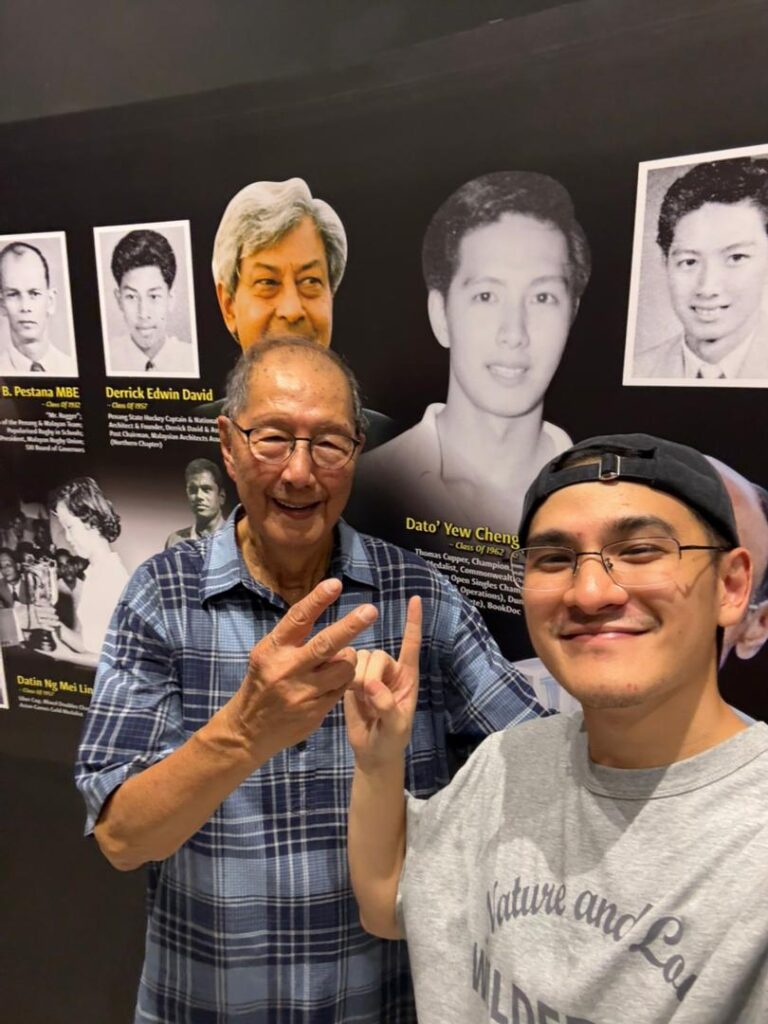
Cheng Hoe (in checked shirt) with Bro. Jason Blaikie (1st left), Puan Sri Hajah Christine Khir Johari and Chuah Han Kim (extreme right)
GEORGE TOWN, Sept 24: Datuk Yew Cheng Hoe’s glorious moments during the pulsating 1967 Thomas Cup clash with Indonesia in Jakarta were relived again at the Hall of Gratitude of St Xavier’s Institution (SXI) here recently.
This came about when Cheng Hoe presented a picture of the victorious Malaysian Thomas Cup team pictured with the prestigious cup and along with then Badminton Association of Malaysia (BAM) President, Tan Sri Khir Johari, and a replica of the much-coveted trophy to the school’s Heritage Centre.
The occasion was witnessed by the widow of Khir, Puan Sri Hajah Christine Khir Johari, and Chuah Han Kim, representing the Penang Badminton Association. Also present at the function were Bro. Jason Blaikie of SXI and Tim Lee, Cheng Hoe’s grandson.
Khir, who had helmed the BAM for 25 years, was instrumental in motivating the Malaysian shuttlers to be oblivious to the hostile crowd in Jakarta as “millions of Malaysian supporters were listening by their radios back home”. (There was no “live” tv broadcasts back then).
Cheng Hoe (Class of 1962 SXI) said after keeping the mementoes for 58 years, he thought that it would be better for the school have them to inspire younger generations of students.
Bro Blaikie, who played a major role in establishing the Hall of Gratitude in 2022, said it was initiated to honour the legacy of Xaverians and that of SXI.
He said since its founding in 1852, SXI has remained a proud pillar of education and character formation in Malaysia.

Cheng Hoe with his grandson, Tim Lee, in front of two pictures of the young Thomas Cupper on the wall
For the record, Cheng Hoe was involved in the historic Thomas Cup final against Indonesia in which Malaysia eventually won. To this day, the Thomas Cup symbolises the supremacy of men’s national badminton teams.
His teammates were Datuk Tan Aik Huang, Datuk Ng Boon Bee, Datuk Tan Yee Khan, Datuk Billie Ng and Datuk Teh Kew San (captain). Reserves in the team were Omar Manap, Tan Aik Mong and Yew Cheng Hock.
In the inter-zonal rounds in June 1967, Malaysia had defeated Denmark 7–2 and Japan 6–3, showcasing its dominance in both singles and doubles.
Some 60 years ago, the Thomas Cup competition was played over nine matches – four (two singles, two doubles) on the first day and five on the second day (an additional singles match and crossover for the players in the two singles and doubles matches).
In the Challenge Round’s finals on June 9 and 10, Malaysia was pitted against defending champions Indonesia. That was the last-ever “challenge round” format, where the defending champion only had to play in the final.
On the first night, Malaysia led 3–1 when Cheng Hoe defeated Indonesian legend Ferry Sonneville 15-9, 15 while Aik Huang lost 6-15, 8-15 to rising star Rudy Hartono (Rudy Nio Hap Liang), who was marking his Thomas Cup debut.
Malaysia forged ahead when its doubles pairs won their matches for 3-1 advantage. Boon Bee and Yee Khan beat AP Unang (Oei Poh Un) and Dermawan Saputra (Tan King Gwan) 15-6, 15-7 while Kew San and Aik Huang beat Muljadi (Ang Tjin Siang) and Hartono 16-17, 15-6 and 15-12 in a tense encounter.
On second night, Aik Huang brought Malaysia on the brink of victory to a 4-1 scoreline with a 15-4, 15-2 win over the ageing Sonneville.
But Indonesia clawed back to win the next two matches when Cheng Hoe lost to Hartono 5-15 and 9-15 while in the 3rd singles, Kew San lost 13-18 and 4-15 to Muljadi.
With the score at 4-3, the first doubles match saw Boon Bee and Yee Khan taking on Muljadi and Agus Susanto (Thio Sie Liong). The Malaysians showed their dominance in the first game with a 15-2 win and were racing towards a convincing victory with a 10-2 lead in the second game.
But things got messy here when the spectators inside the Istora Senayan Stadium erupted several times with loud jeers and distractions, used mirrors and flashlights to blind the players and created a continuous din to upset concentration. Yee Khan and Boon Bee eventually lost 13-18.
After a noisy 15-minute break, the “rubber” game could not be resumed as it was during this time the crowd became even more unruly.
The match had to be abandoned. Fearing for their safety, the Malaysians left Jakarta under the cover of darkness. Cheng Hoe described the terrifying events as scary.
The International Badminton Federation (the forerunner of the current Badminton World Federation) then decided that the remaining matches be played at a neutral venue in Auckland, New Zealand in October 1967.
But Indonesia declined to play at the venue and the controversial tie was awarded to Malaysia at 6-3.
The incident highlighted the limitations of the Challenge Round format, which gave undue advantage to the defending champion. That 1967 controversy in Jakarta contributed to the abolition of the Challenge Round system. It also underscored the need for neutral venues and fair play standards as seen in current day tournaments.
WE
Feature Your Event in Weekly Echo
We invite organisations, companies and schools to contact us at 012-2037137 to have your events featured. Let’s work together to amplify your stories and support sustainable journalism.